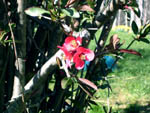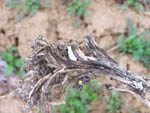Quince blooms in late winter and can be an important source of nectar and pollen for syrphids and other insects. |
Dandylion will bloom anytime of the year, and in winter it is an important pollen and nectar source. |
There are many winter blooming shrubs - here, a holly is blooming and provides nectar and pollen. |
| Yarrow leaves, because they are feathered, become excellent overwintering sites for parasitic wasps and other small insects |
The cocoons of Cotesia glomerata, along with the dead imported cabbageworm caterpillar, are on the broccoli stalk in the fall. |
By allowing a portion of the field to lay fallow, or selectively protect plants with cocoon masses, we can boost our natural enemy levels to high numbers early in the season. Here are two cocoon masses on one plant - protect! |





